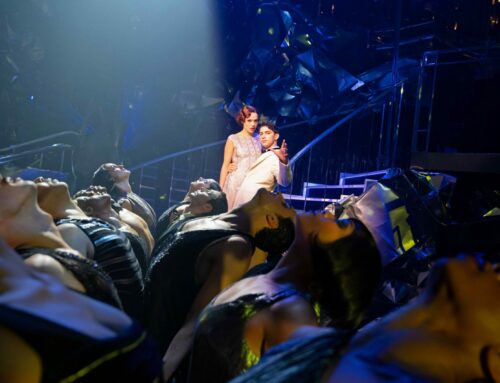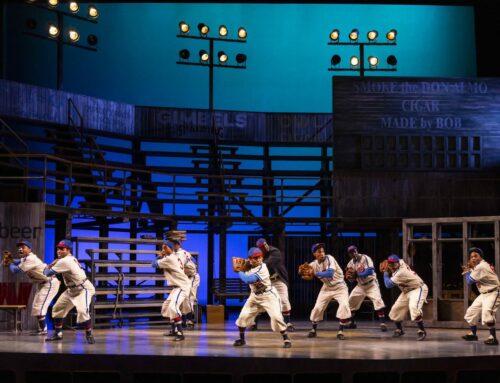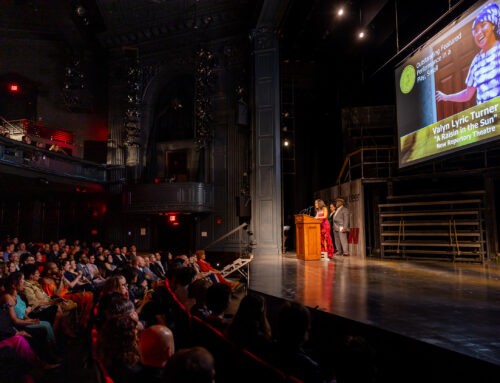SWEENEY TODD: THE DEMON BARBER OF FLEET STREET kicks off the soft opening of a new performance space in Harvard Square. What used to be the A.R.T.’s second stage Club Oberon is now ARROW STREET ARTS home to Moonbox Productions which delivers a well-sung but awkwardly-mounted production of Stephen Sondheim’s Tony Award-winning musical. The cast is in control of the difficult operatic score with its odd intervals, ingenious lyrics, and haunting melodies, but misguided staging and slack direction blunt the dramatic edge of what might have been a thrilling update on a penny dreadful.
The opening lyrics invite us to “Attend the tale of Sweeney Todd,” a blood-soaked melodrama involving murder, cannibalism, rape, corruption, and incest. Before he was the demonic Sweeney Todd, he was Benjamin Barker, a talented barber victimized by the sadistic Judge Turpin (a perfectly sinister Todd Yard) who covets Barker’s beautiful wife. The judge first sends Barker to prison on trumped up charges, then rapes his wife propelling her into madness, then kidnaps their daughter Johanna (Eva Akina Huertes Colliou) whom he now plans to make his child bride.
Davron S. Monroe is a moving Sweeney Todd, his vocals rich and emotive, relaying the pain beneath the madness fueling his bloody deeds which, as luck would have it, supply his landlady Mrs. Lovett with fillings for her meat pies! It seems Sweeney’s thirst for revenge has metastasized; he now slits the throats of anyone unlucky enough to sit in his chair at the wrong moment. In Monroe’s raw but vulnerable portrayal, we almost feel some sympathy for the cruelly misused Sweeney.
Mrs Lovett played by Joy Clark, is a wonderful vocalist but lacks the dotty edge this part demands. A woman who has no trouble putting people into pies must be just a little off. It’s a dimension co-producer/director Ryan Mardesich might have teased out of this capable actress who instead limits her portrayal to that of a lonely woman hungry for a man. Caitlin Zerra Rose as a beggar woman, has a vibrant voice, but perhaps too vibrant an appearance for someone whose life experience has reduced to being unrecognizable.
As for the young lovers, the aforementioned Johanna and her suitor Anthony Hope have zero chemistry. I didn’t for a second believe Dallas Austin Jimmar as the smitten young sailor, despite having one of the best voices in the ensemble. I wish he had at least been directed to stand completely still instead of navigating steps, when, lovestruck, he delivers one of the most rapturously beautiful ballads in musical theater history, “Johanna.” As for the virginal Johanna given that the score specifically describes her “yellow hair” and makes a plot point of the color of her golden locks–why is she brunette? And why is she wearing her white ruffled frock half way down her arms about to fall off? I also would have loved to have seen ensemble member Tim Lawton–with that imposing presence and set of pipes–cast as Sweeney’s rival barber Mr. Pirelli.
The scenic design (Cameron McEachern) and staging are also problematic. The stairs and balcony stage left are used for Turpin’s house where Johanna is trapped, and also indicates Johanna’s prison. But the location is also used for assorted other exits and entrances often leaving me lost in space, while upstage right is wasted on a big, pointless neon sign.
But the biggest miscalculation is placing the oven upstage center into which fresh victims ascend, zombie-like, via a ramp up to the final bake-off. Sweeney’s barber’s chair is usually a sort of medieval contraption rigged to sleekly slide his victims down into the bake oven with macabre efficiency. The action is funny and horrible at the same time. Here, the dark fun is missing and the production has put nothing new in its place, even though the approach to this material has been described as “Brechtian,” and the setting as “London. 1846” as well as “The theatre you are sitting in. Now.” That would have been a relevant take on the material and this production could have skewed the musical into more overtly political territory, more pointedly broken the fourth wall, and stressed the societal inequities undergirding the action in its direction and design. Alas, little of this emphasis is in evidence here. This SWEENEY TODD has given us the requisite number of murders, but has left us with a concept in search of execution.
SWEENEY TODD: THE DEMON BARBER OF FLEET STREET is onstage at ARROW STREET ARTS through November 5.







Leave A Comment
You must be logged in to post a comment.